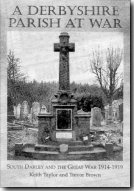Review of ‘A Derbyshire Parish At War’, by Keith Taylor and Trevor BrownThis review is by Julie Bunting, and was published originally in The Peak Advertiser, the Peak District's local free newspaper, on 22nd January 2001, and is reproduced with Julie's kind permission.
At the start of the war the British Expeditionary Force was made up of only 120,000 men and in August 1914 Lord Kitchener called for 100,000 volunteers. By 15 September, when a recruitment meeting was held at South Darley, half a million men had enlisted as volunteers. During the next four dreadful years, twenty-two families of South Darley were left mourning their sons including two lads of eighteen and a number of family men. Remarkably, nineteen of the fallen had been regular churchmen, including four members of the choir. The twenty-two names inscribed on the war memorial in St. Mary's churchyard were a starting point for the authors in compiling A Derbyshire Parish at War. Their thorough research gives us some idea of the pride and suffering of just this one small parish, from the nineteen-year-old who fell in 'the finest action of the 14th Battalion Durham Light Infantry of the entire Great War' to the 'Year of Tragedy', 1917, when seven South Darley men were lost within three months, an eighth man dying later of his wounds. Extracts from letters home are, of course, poignant and sombre but clearly the men often tried to put a brave face on things for those back home, to the extent that one was reported to be 'having the time of his life' and another declared himself 'in the pink, never better.' But by contrast: 'we who are left think ourselves lucky ... [Thiepval] is in our hands completely now, but it was nothing else, only murder, but that has got to be done ...' Thoughts of home make touching reading: 'We are fighting in hills just like Oker' or 'the place we left was hotter than Colman's mustard'. Nostalgic days of football and cricket are written of frequently and we learn that every member of the 1914 Wensley Wuffits football team went to fight in the war; two did not return. Of the twenty-two names on the South Darley war memorial, not one descendant is now believed to live in the parish. Nevertheless, the authors must be gratified to find that links remain strong both here and in surrounding villages as well as much further afield. Review by Julie Bunting |
|||
